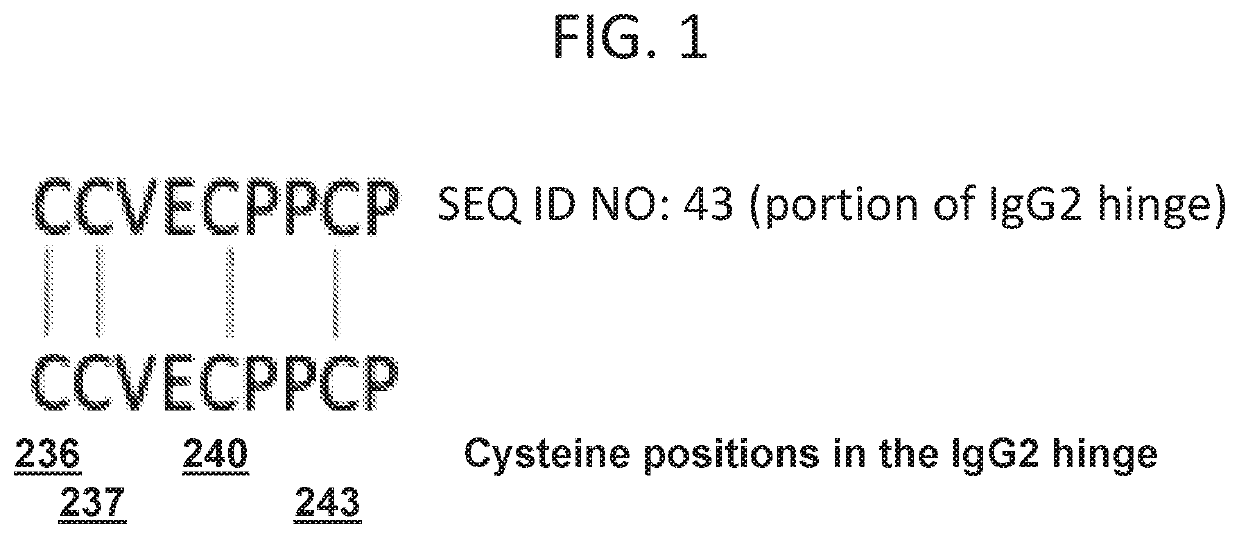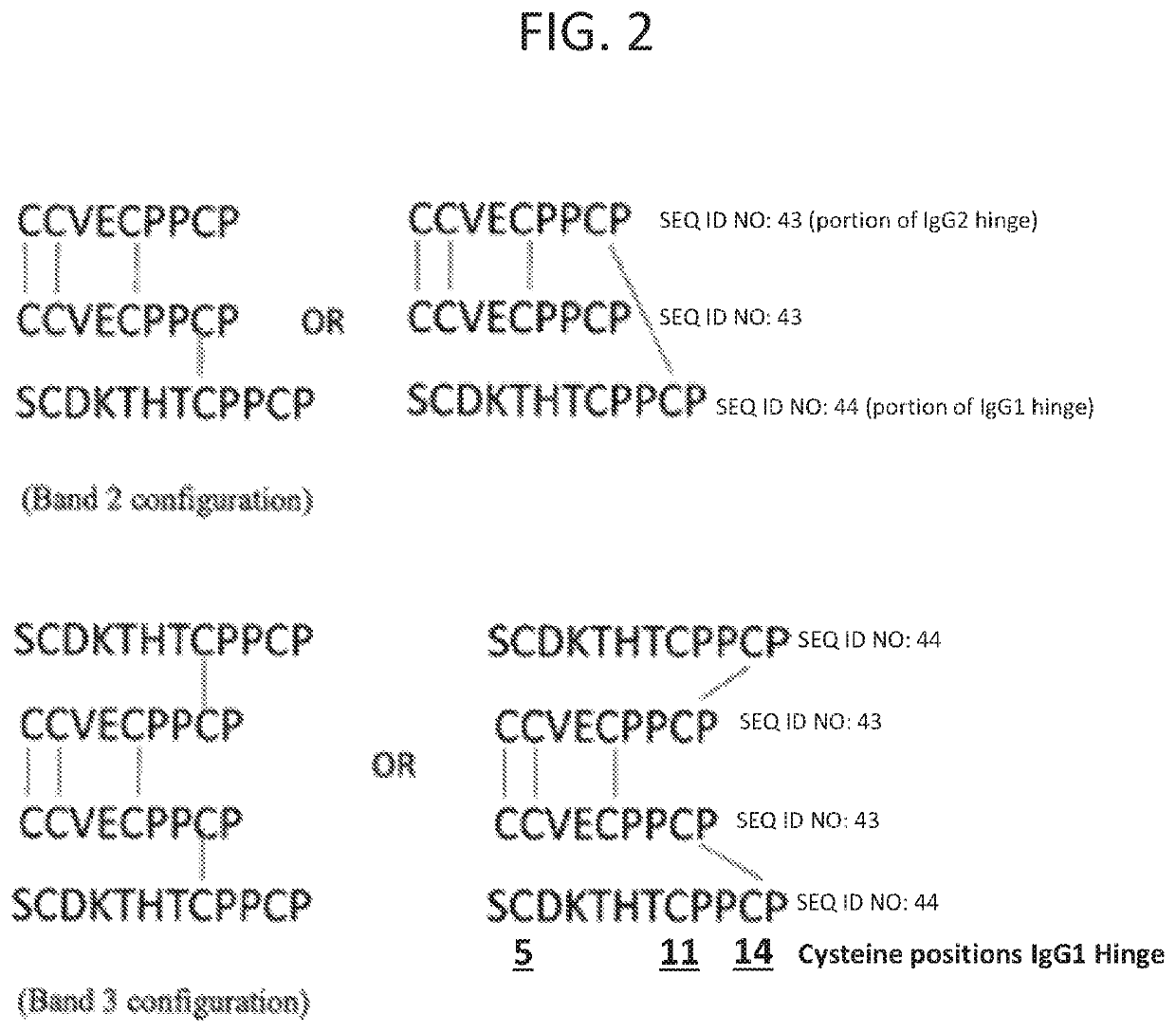Cysteine-optimized stradomers
a technology of stradomers and cysteine, which is applied in the direction of peptides, immunoglobulins, peptide/protein ingredients, etc., can solve the problems of potential liability of cysteine residues that are not involved in the formation of tertiary structures, and achieve the effects of reducing multimerization, reducing multimerization, and reducing functionality
- Summary
- Abstract
- Description
- Claims
- Application Information
AI Technical Summary
Benefits of technology
Problems solved by technology
Method used
Image
Examples
example 1
igest Disulfide Bond Analysis of GL-2045
[0123]The disulfide bond structure of GL-2045 was analyzed by SDS-PAGE analysis followed by tryptic digests of bands 1-4, representing the homodimer (band 1), the dimer of the homodimer (band 2) the trimer of the homodimer (band 3) and the dimer of the dimer (the tetramer of the homodimer) (band 4). Digests were separated by HPLC with UV detection, and analyzed by in-line mass spectroscopy using a time of flight mass spectrometer (Agilent) equipped with electrospray ionization operating in a positive ion mode. The mass analysis from the peptide mapping separation was analyzed using Bioconfirm (Agilent). Sequence coverage of 100% was obtained for all four bands.
[0124]As described above, GL-2045 cysteines are present at positions 5, 11, 14, 46, 106, 152, 210, 236, 237, 240, and 243 of the stradomer unit monomer that comprise GL-2045. The GL-2045 disulfide bond analysis indicated that for band 1, the homodimer, cysteine residues at positions 5, 1...
example 2
l Analysis of Single Cysteines in GL-2045
[0134]To further analyze the involvement of the individual cysteines in multimer formation, a mutational analysis was performed, wherein each individual cysteine was mutated to a serine residue. The effects of these individual mutations on multimer formation were analyzed by non-reducing SDS-PAGE.
[0135]GL-2045 variants were generated by PCR and cloned into expression vector pcDNA3.3. The variants were then expressed in HEK or CHO cells and purified by protein A affinity chromatography. Multimerization of each compound was then compared with GL-2045 by non-reducing SDS-PAGE analysis using Invitrogen gels that provided the highest resolution of higher order bands.
[0136]Single mutations were made of each of the individual cysteine residues in the IgG1 hinge domain monomer (Table 4), the IgG1 CH2 and CH3 domain monomers (Table 5), and the IgG2 hinge domain monomer (Table 6). For each of Tables 4-6, positions at which the cysteines were mutated to...
example 3
Triple Mutational Analysis of GL2045
[0143]In order to further assess the ability to cysteine-optimize multimerizing stradomers, dual mutations were made of each of pair of cysteine residues in the IgG1 hinge domain monomer (Table 7) and a triple mutation was made of all cysteine residues in the IgG1 hinge domain monomer (Table 8). In addition, a dual mutation was made in two of the cysteine residues in the IgG2 CH2 CH3 domain monomers (Table 9). For each of Tables 7-9, positions at which the cysteine was mutated to serine are in bold and underlined text.
[0144]
TABLE 7Dual Mutations in IgG1 hingeCompoundMutationIgG1 Hinge SequenceSEQ ID NO.G899CHSEPKSCDKTHTSPPSP22C14SG948C5SEPKSSDKTHTCPPSP23C14SG949C5SEPKSSDKTHTSPPCP24C11S
[0145]
TABLE 9Triple Mutations in IgG1 hinge CompoundMutationIgG1 Hinge SequenceSEQ ID NO.G930C5SEPKSSDKTHTSPPSP25C11SC14S
[0146]The effects of dual cysteine mutations in the IgG1 hinge domain monomer on stradomer multimer formation are shown in FIG. 6. For G948, two i...
PUM
| Property | Measurement | Unit |
|---|---|---|
| concentrations | aaaaa | aaaaa |
| concentrations | aaaaa | aaaaa |
| concentrations | aaaaa | aaaaa |
Abstract
Description
Claims
Application Information
 Login to view more
Login to view more - R&D Engineer
- R&D Manager
- IP Professional
- Industry Leading Data Capabilities
- Powerful AI technology
- Patent DNA Extraction
Browse by: Latest US Patents, China's latest patents, Technical Efficacy Thesaurus, Application Domain, Technology Topic.
© 2024 PatSnap. All rights reserved.Legal|Privacy policy|Modern Slavery Act Transparency Statement|Sitemap



